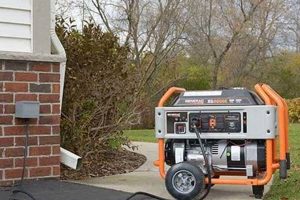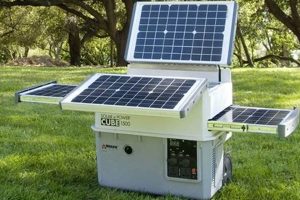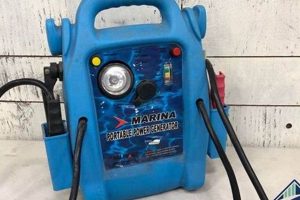A lack of electrical output from a mobile, engine-driven generating unit can stem from various factors. For instance, a depleted fuel supply, a clogged carburetor, or a faulty spark plug could prevent the engine from starting or running correctly. Similarly, issues within the generator’s electrical system, such as a tripped circuit breaker, a malfunctioning voltage regulator, or damaged wiring, can interrupt power delivery even if the engine operates as expected.
Understanding the reasons behind a non-functional mobile generating unit is essential for ensuring reliable backup power during outages. This knowledge allows users to troubleshoot problems effectively, perform necessary maintenance, and ultimately restore functionality when needed most. Historically, these units have evolved from bulky, noisy machines to more compact and quieter versions, increasing their accessibility and usability for various applications, from emergency home power to recreational activities. The ability to diagnose and rectify operational issues remains crucial regardless of the unit’s sophistication.
This article will delve into the common causes of power failures in mobile generators, offering troubleshooting steps and preventative maintenance advice to ensure consistent performance. Topics covered will include fuel system checks, engine maintenance procedures, and electrical system diagnostics.
Troubleshooting a Non-Functional Portable Generator
Addressing power failures in portable generators requires a systematic approach. The following tips offer guidance for diagnosing and resolving common issues.
Tip 1: Check the Fuel Level. Ensure the fuel tank contains sufficient gasoline. A low fuel level is the most frequent cause of startup failure.
Tip 2: Inspect the Fuel Lines. Verify fuel lines are securely connected and free from kinks or blockages that could restrict fuel flow.
Tip 3: Examine the Air Filter. A dirty or clogged air filter restricts airflow to the engine. Clean or replace the air filter as needed.
Tip 4: Inspect the Spark Plug. Remove and inspect the spark plug. A fouled, worn, or damaged spark plug will prevent ignition. Clean, adjust the gap, or replace the spark plug as necessary.
Tip 5: Verify the Oil Level. Low oil levels can cause engine damage and prevent operation. Check and add oil as required.
Tip 6: Check Circuit Breakers. Tripped circuit breakers within the generator will interrupt power delivery. Reset any tripped breakers.
Tip 7: Inspect the Voltage Regulator. A faulty voltage regulator can prevent the generator from producing power. Test the voltage regulator and replace it if necessary.
By following these diagnostic tips, one can often restore functionality to a non-operational portable generator. Regular maintenance can prevent many of these issues.
This practical guidance provides a foundation for effective troubleshooting and empowers users to maintain reliable backup power.
1. Fuel Level
A portable generator requires fuel to operate; therefore, the fuel level is a critical factor in diagnosing power failures. Insufficient fuel is the most common reason a generator fails to start or stops running during operation. Understanding the role of fuel level and its associated components provides a foundation for effective troubleshooting.
- Fuel Gauge Accuracy
While fuel gauges provide an estimate of the fuel level, their accuracy can vary. A faulty gauge might indicate a sufficient level when the tank is nearly empty. This can lead to unexpected shutdowns, especially during extended operation. Regularly verifying the fuel level visually, rather than relying solely on the gauge, is crucial. For example, a generator used for backup power during an outage may unexpectedly stop due to a faulty gauge reading, leaving critical systems without power.
- Fuel Consumption Rate
Generators consume fuel at varying rates depending on the load and engine size. Operating a generator near its maximum capacity will deplete the fuel supply more rapidly. Understanding the consumption rate allows for accurate estimations of runtime and facilitates timely refueling. Failure to account for the consumption rate can lead to power interruptions during critical periods, such as during a power outage or while powering essential equipment at a remote location.
- Fuel Type and Quality
Using the incorrect fuel type or stale, contaminated fuel can negatively impact generator performance. Gasoline generators require fresh, clean gasoline. Using old gasoline or mixing gasoline with oil can lead to engine damage and starting difficulties. Maintaining a supply of fresh, appropriate fuel is vital for reliable generator operation.
- Fuel Tank Capacity
Generators come with varying fuel tank capacities. Larger tanks provide longer runtimes, while smaller tanks require more frequent refueling. Selecting a generator with an appropriate fuel tank capacity depends on the intended application and expected runtime requirements. For instance, extended power outages or remote applications necessitate larger fuel capacities.
Regularly monitoring the fuel level, understanding the fuel consumption rate, using the correct fuel type, and selecting a generator with an appropriate fuel tank capacity contribute significantly to reliable operation and mitigate the risk of power failures.
2. Fuel Lines
Fuel lines play a critical role in the operation of a portable generator. These lines transport fuel from the tank to the carburetor, where it mixes with air and is ignited to power the engine. Any issue within the fuel lines can directly result in power failure. Blockages, leaks, or disconnections interrupt the fuel supply, starving the engine and preventing power generation. For example, a kinked fuel line restricts fuel flow, leading to a sputtering engine and ultimately, power loss. A deteriorated fuel line can leak, creating a fire hazard and depleting the fuel supply, causing the generator to shut down. Even a loose fuel line connection can introduce air into the system, disrupting the fuel-air mixture and preventing proper combustion.
Understanding the potential issues related to fuel lines is essential for effective troubleshooting and preventative maintenance. Regular inspection of fuel lines for cracks, kinks, and secure connections can prevent unexpected power failures. Replacing aged or damaged fuel lines proactively mitigates risks associated with leaks and fuel starvation. In practical applications, such as providing backup power during emergencies, maintaining properly functioning fuel lines ensures the generator remains operational when needed most. For instance, during a natural disaster, a compromised fuel line could render a generator unusable, jeopardizing critical services reliant on backup power.
In summary, fuel lines represent a crucial component within the fuel delivery system of a portable generator. Maintaining their integrity is paramount for consistent power generation. Regular inspections and timely replacement of compromised lines minimize the risk of power failures and ensure the generator functions reliably when called upon. Addressing fuel line issues proactively contributes significantly to the overall dependability of the portable generator, especially in situations where uninterrupted power is essential.
3. Air Filter
The air filter plays a crucial role in the operation of a portable generator, directly impacting its ability to produce power. A clean air filter allows the correct air-fuel mixture to reach the engine’s combustion chamber, ensuring efficient operation. Conversely, a dirty or clogged air filter restricts airflow, leading to a rich fuel mixture, incomplete combustion, and potentially a complete loss of power.
- Airflow Restriction
A clogged air filter acts as a barrier, reducing the volume of air reaching the engine. This restriction starves the engine of the oxygen necessary for complete combustion. The resulting rich fuel mixture can foul spark plugs, leading to misfires and reduced power output. In severe cases, the engine may stall entirely, resulting in a complete power outage. This is particularly problematic in situations where the generator provides essential backup power.
- Engine Overheating
Restricted airflow due to a clogged air filter can also lead to engine overheating. The reduced airflow limits the engine’s ability to dissipate heat, potentially causing damage to internal components. Overheating can manifest as reduced power output, engine misfires, and in extreme cases, engine seizure. This can lead to costly repairs and extended downtime.
- Increased Fuel Consumption
A rich fuel mixture, caused by a clogged air filter, results in inefficient fuel consumption. The engine burns more fuel to produce less power, reducing the generator’s runtime and increasing operating costs. This inefficiency is particularly noticeable under heavy loads, further impacting performance and potentially causing premature engine wear.
- Impact on Emissions
Incomplete combustion due to restricted airflow leads to increased emissions of pollutants, including carbon monoxide. This poses health risks, especially in enclosed or poorly ventilated areas. Regular air filter maintenance not only ensures optimal generator performance but also minimizes environmental impact.
In summary, the air filter’s condition directly correlates to the portable generator’s ability to produce power reliably. Regular maintenance, including cleaning or replacing the air filter according to the manufacturer’s recommendations, is essential for preventing power failures, maximizing fuel efficiency, prolonging engine life, and minimizing harmful emissions. Neglecting air filter maintenance can lead to costly repairs, reduced performance, and potentially hazardous operating conditions. Therefore, maintaining a clean air filter is paramount for ensuring reliable and efficient power generation.
4. Spark Plug
The spark plug is a critical component in a portable generator’s ignition system, directly influencing its ability to produce power. A functioning spark plug ignites the air-fuel mixture within the combustion chamber, initiating the power stroke that drives the engine. A malfunctioning spark plug disrupts this process, leading to performance issues and potential power failures. Understanding the spark plug’s role and potential failure points is essential for troubleshooting and maintaining reliable generator operation.
- Spark Plug Gap
The spark plug gap, the distance between the center and ground electrodes, is crucial for proper ignition. An incorrect gap can result in a weak spark or no spark at all. A gap that is too narrow may not ignite the air-fuel mixture, while a gap that is too wide can lead to misfires, especially under load. Maintaining the correct gap, as specified by the manufacturer, ensures reliable ignition and optimal engine performance. For instance, a generator struggling to start or exhibiting intermittent power loss may have an incorrectly gapped spark plug.
- Spark Plug Fouling
Spark plug fouling occurs when deposits accumulate on the electrodes, hindering spark formation. These deposits can result from oil contamination, excessive fuel mixture, or wear and tear. A fouled spark plug can cause misfires, rough running, and difficulty starting. Regular inspection and cleaning or replacement of fouled spark plugs are essential for maintaining reliable generator performance. A generator used infrequently might experience fouling due to stale fuel deposits.
- Spark Plug Wear
Over time, the electrodes of a spark plug wear down, increasing the gap and weakening the spark. This wear can lead to reduced engine performance, difficulty starting, and increased fuel consumption. Replacing worn spark plugs according to the manufacturer’s recommendations ensures consistent ignition and optimal engine efficiency. A generator exhibiting decreased power output despite adequate fuel and maintenance may require spark plug replacement due to electrode wear.
- Connection and Wiring
A loose or damaged spark plug wire can disrupt the electrical connection, preventing the spark plug from firing. This can lead to misfires, rough running, or a complete inability to start. Ensuring secure connections and inspecting the spark plug wire for damage are crucial for reliable ignition. A generator that suddenly stops producing power may have a disconnected or damaged spark plug wire.
In conclusion, the spark plug plays a vital role in the portable generator’s operation. Addressing spark plug-related issues, such as incorrect gap, fouling, wear, and connection problems, directly contributes to reliable power generation. Regular inspection and maintenance of spark plugs, including cleaning, gapping, and timely replacement, are crucial for preventing power failures and ensuring the generator’s dependable performance, especially in situations where continuous power is essential.
5. Oil Level
Maintaining the correct oil level is crucial for the reliable operation of a portable generator. Insufficient oil can lead to catastrophic engine damage, resulting in power loss and costly repairs. Conversely, excessive oil can cause other operational problems. Understanding the various facets of oil level management contributes significantly to preventing power failures and ensuring the generator’s longevity.
- Lubrication and Engine Protection
Engine oil provides essential lubrication for moving parts within the engine, reducing friction and preventing wear. Insufficient oil starves these components of lubrication, leading to increased friction, overheating, and potentially seizure. This can result in a sudden loss of power and significant engine damage. For instance, operating a generator with low oil during a power outage could lead to engine failure, precisely when power is most needed.
- Oil Level Monitoring and Maintenance
Regularly checking the oil level is essential preventative maintenance. Generators typically have a dipstick for measuring the oil level. Checking the oil before each use, especially during extended operation, helps prevent damage caused by low oil levels. Adding oil as needed ensures proper lubrication and protects the engine from wear. Ignoring routine oil checks could result in undetected leaks gradually leading to a critical low-oil situation and subsequent engine damage.
- Oil Type and Viscosity
Using the correct oil type and viscosity, as specified by the manufacturer, is crucial for optimal engine performance. Using incorrect oil can affect lubrication effectiveness and engine temperature regulation, potentially leading to reduced power output and increased wear. Referring to the owner’s manual for specific oil recommendations ensures proper engine protection and performance. Using an oil with incorrect viscosity in extreme temperatures could lead to inadequate lubrication and increased engine wear.
- Oil Changes and Engine Longevity
Regular oil changes are essential for removing contaminants and maintaining the oil’s lubricating properties. Over time, engine oil degrades and accumulates debris, reducing its effectiveness. Adhering to the manufacturer’s recommended oil change intervals ensures optimal engine performance and prolongs its lifespan. Neglecting oil changes can lead to increased engine wear, reduced power output, and potentially catastrophic engine failure.
In summary, maintaining the correct oil level, using the correct oil type, and adhering to a regular maintenance schedule are crucial for preventing “portable generator no power” scenarios. Proper oil management protects the engine, ensures reliable power generation, and extends the generator’s operational life, providing dependable power when needed.
6. Circuit Breakers
Circuit breakers within a portable generator serve as crucial safety devices, protecting the generator and connected equipment from overloads and short circuits. These overloads can stem from attempting to draw more power than the generator’s capacity or from a fault in the connected devices. When a circuit breaker trips, it interrupts the flow of electricity, effectively shutting down the generator or a specific portion of its output. This interruption manifests as a “portable generator no power” situation. Understanding the function and operation of circuit breakers is essential for troubleshooting and resolving power failures in portable generators.
- Overload Protection
Circuit breakers protect the generator’s internal components from damage caused by excessive current draw. When the electrical load exceeds the generator’s rated capacity, the circuit breaker trips, preventing overheating and potential damage to the windings and other electrical components. For example, connecting too many appliances or devices simultaneously can overload the generator, causing the circuit breaker to trip and interrupt power delivery.
- Short Circuit Protection
A short circuit occurs when a low-resistance path is created in the electrical circuit, allowing excessive current to flow. This can generate significant heat and potentially cause fires. Circuit breakers react rapidly to short circuits, interrupting the current flow and preventing damage to the generator and connected equipment. A damaged appliance with exposed wiring could create a short circuit, tripping the generator’s breaker.
- Manual Reset and Troubleshooting
Most circuit breakers in portable generators are manually resettable. After a trip, identifying and resolving the underlying cause of the overload or short circuit is crucial before resetting the breaker. Attempting to reset the breaker without addressing the root cause can lead to repeated tripping and potential damage. For instance, if a tripped breaker is immediately reset without disconnecting the excessive load, it will likely trip again.
- Types of Circuit Breakers
Portable generators typically utilize thermal or magnetic circuit breakers. Thermal breakers react to heat generated by excessive current, while magnetic breakers react to the magnetic field generated by a surge in current. Both types serve the same purpose of interrupting the circuit to prevent damage. Understanding the type of breaker in a specific generator can aid in troubleshooting and choosing appropriate replacement components. A thermal breaker might trip due to sustained overload, whereas a magnetic breaker would trip instantaneously in response to a short circuit.
In conclusion, circuit breakers are essential safety components in portable generators, preventing damage and ensuring safe operation. Understanding their function and response to overloads and short circuits is crucial for troubleshooting and resolving “portable generator no power” situations. Regularly checking the circuit breakers and addressing the underlying causes of tripping contribute significantly to the reliable operation of the generator and the safety of connected equipment.
7. Voltage Regulator
The voltage regulator plays a critical role in maintaining a stable voltage output from a portable generator. A malfunctioning voltage regulator is a significant contributor to “portable generator no power” scenarios, often manifesting as fluctuating or absent voltage, rendering the generator unusable. Understanding its function and potential failure points is crucial for effective troubleshooting and ensuring reliable power delivery.
- Voltage Stability and Power Delivery
The voltage regulator maintains consistent voltage output regardless of the fluctuating engine speed and load. This stability is crucial for protecting sensitive electronic devices connected to the generator. Without a functioning regulator, voltage fluctuations can damage these devices, leading to malfunctions or permanent failure. For example, a voltage spike could damage a computer’s power supply, while consistently low voltage could prevent it from operating correctly.
- Overvoltage and Undervoltage Protection
The voltage regulator protects against both overvoltage and undervoltage conditions. Overvoltage, caused by sudden load reductions or internal faults, can damage connected equipment. Undervoltage, often due to overloading or regulator malfunction, can prevent devices from operating correctly or cause them to overheat. The regulator maintains a safe voltage range, preventing these potentially damaging scenarios. For instance, during a sudden decrease in load, the regulator prevents a voltage spike that could damage connected light bulbs.
- Components and Failure Points
Voltage regulators typically consist of electronic components, such as capacitors, diodes, and transistors, which are susceptible to failure due to age, heat, or voltage surges. A failed capacitor could lead to erratic voltage fluctuations, while a faulty diode could result in no voltage output. Understanding these components and their potential failure modes helps diagnose regulator-related power issues. A generator subjected to frequent overloads might experience premature regulator failure due to component stress.
- Testing and Replacement
Testing a voltage regulator typically involves measuring the output voltage under various load conditions. Specialized multimeters or diagnostic tools may be required. If testing reveals a faulty regulator, replacement is usually the necessary course of action. Attempting to repair a voltage regulator is often impractical due to its complex circuitry and the availability of affordable replacement units. A generator consistently producing low voltage, despite normal engine operation, likely requires voltage regulator replacement.
In conclusion, the voltage regulator is essential for ensuring a stable and safe power supply from a portable generator. A malfunctioning regulator is a frequent cause of “portable generator no power” situations, impacting the functionality and safety of connected equipment. Understanding its function, potential failure points, and testing procedures is crucial for diagnosing and resolving power delivery problems, ensuring the generator’s reliable operation and the safety of connected devices.
Frequently Asked Questions
This section addresses common inquiries regarding portable generator power failures, providing concise and informative responses to facilitate effective troubleshooting and maintenance.
Question 1: Why does the generator run but produce no power?
Several factors can cause this issue, including a tripped circuit breaker, a faulty voltage regulator, loose or damaged wiring, or problems with the generator’s outlets. Systematic troubleshooting is necessary to identify the specific cause.
Question 2: What should be checked first when a generator fails to start?
The initial checks should focus on the fuel system. Ensure sufficient fuel, check for clogged fuel lines or filters, and inspect the spark plug. A faulty spark plug often prevents engine ignition.
Question 3: How does a clogged air filter affect generator performance?
A clogged air filter restricts airflow to the engine, leading to incomplete combustion and reduced power output. It can also cause overheating and increased fuel consumption. Regular air filter cleaning or replacement is essential.
Question 4: Why does the generator’s circuit breaker keep tripping?
Repeated tripping indicates an overload or a short circuit. Identify and disconnect any devices exceeding the generator’s rated capacity or exhibiting faulty wiring. A persistent problem may require professional service.
Question 5: What are the signs of a failing voltage regulator?
Fluctuating voltage, dimming lights, or devices not operating correctly are indicative of a faulty voltage regulator. Testing the voltage output with a multimeter can confirm the diagnosis.
Question 6: How often should generator maintenance be performed?
Regular maintenance, as outlined in the owner’s manual, is crucial for reliable operation. This typically includes oil changes, air filter cleaning or replacement, spark plug inspection, and fuel system checks. More frequent maintenance might be necessary in demanding operating conditions.
Addressing these common issues proactively ensures reliable generator operation and minimizes the risk of power failures when needed most.
This FAQ section provides foundational knowledge for troubleshooting common generator issues. The following sections delve deeper into specific maintenance procedures and advanced diagnostic techniques.
Conclusion
A non-functional portable generator often arises from several common but preventable issues. This exploration has examined critical areas, including fuel system integrity, proper maintenance of the air filter and spark plug, sufficient oil levels, the function of circuit breakers, and the role of the voltage regulator in maintaining stable power output. Neglecting these areas can lead to power failures, particularly during critical situations when backup power is most essential. Understanding the underlying causes and implementing appropriate preventative measures significantly reduces the risk of encountering a non-operational unit.
Reliable generator operation necessitates proactive maintenance and informed troubleshooting. Regular inspections, adherence to manufacturer recommendations, and timely replacement of worn components contribute to consistent performance. Equipping oneself with the knowledge presented herein empowers individuals to address power failures effectively, ensuring access to critical backup power when needed. Investing in preventative maintenance and developing troubleshooting skills ultimately fosters greater preparedness and self-reliance in the face of power disruptions.






